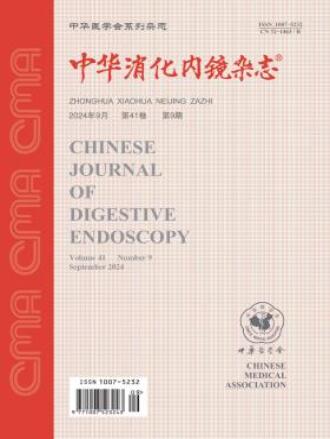A comparative study on transnasal gastroscopy and conventional gastroscopy for percutaneous endoscopic pancreatic necrosectomy
引用次数: 1
Abstract
Objective To compare the therapeutic value of transnasal gastroscopy and conventional gastroscopy for infective pancreatic necrosis(IPN) through percutaneous endoscopic necrosectomy(PEN). Methods A total of 24 IPN patients who received PEN for IPN from December 2015 to March 2019 were divided into the conventional gastroscopy group (n=15) and the transnasal gastroscopy group (n=9). The clinical therapeutic indicators such as vital signs, APACHE Ⅱ score changes, operation duration, difference in preoperative and postoperative volumes of peripancreatic necrosis and other indicators were compared between the two groups. Results There was no significant difference in the variation curve fitting of APACHE Ⅱ scores between the two groups (t=0.378, P=0.710). The operation time of the transnasal gastroscopy group was significantly shorter than that of the conventional gastroscopy group (119.7±47.4 min VS 172.8±56.2 min, P=0.018). Peripancreatic necrotic volume significantly decreased after operation in the transnasal gastroscopy group (404.03±170.73 mL VS 468.9±137.37 mL, P=0.002), and in the conventional gastroscopy group (499.44±227.17 mL VS 722.50±292.96 mL, P<0.001). There was no significant difference in the decrease extent in the conventional gastroscopy group and the transnasal gastroscopy group (223.06±212.92 mL VS 64.87±54.94 mL, P= 0.094). Conclusion On the condition of poor drainage of percutaneous catheter drainage, PEN can significantly reduce the range of necrotic lesions. Transnasal gastroscopy has the advantages in operation time in PEN and clearing deep abscess cavities over conventional gastroscopy. Key words: Pancreatitis; Percutaneous endoscopic necrosectomy; Infective pancreatic necrosis经鼻胃镜与常规胃镜在经皮内镜胰腺坏死切除术中的比较研究
目的比较经皮内镜下坏死切除术(PEN)经鼻胃镜与常规胃镜对感染性胰腺坏死(IPN)的治疗价值。方法将2015年12月至2019年3月接受PEN治疗的24例IPN患者分为常规胃镜组(n=15)和经鼻胃镜组(n=9)。比较两组患者的生命体征、APACHEⅡ评分变化、手术时间、术前和术后胰周坏死量的差异等临床治疗指标。结果两组APACHEⅡ评分变化曲线拟合无显著性差异(t=0.378,P=0.710),经鼻胃镜检查组手术时间明显短于常规胃镜检查组(119.7±47.4min VS 172.8±56.2min,P=0.018)经鼻胃镜检查组(404.03±170.73mL VS 468.9±137.37mL,P=0.002),常规胃镜检查组(499.44±227.17 mL VS 722.50±292.96 mL,P<0.001)。常规胃镜检查和经鼻胃镜检查组的下降幅度(223.06±212.92 mL VS 64.87±54.94 mL,P=0.094)无显著差异,PEN可以显著减少坏死病变的范围。与传统胃镜相比,经鼻胃镜在PEN手术时间和清除深脓肿腔方面具有优势。关键词:胰腺炎;经皮内镜尸检;感染性胰腺坏死
本文章由计算机程序翻译,如有差异,请以英文原文为准。
求助全文
约1分钟内获得全文
求助全文
来源期刊
CiteScore
0.10
自引率
0.00%
发文量
7555
期刊介绍:
Chinese Journal of Digestive Endoscopy is a high-level medical academic journal specializing in digestive endoscopy, which was renamed Chinese Journal of Digestive Endoscopy in August 1996 from Endoscopy.
Chinese Journal of Digestive Endoscopy mainly reports the leading scientific research results of esophagoscopy, gastroscopy, duodenoscopy, choledochoscopy, laparoscopy, colorectoscopy, small enteroscopy, sigmoidoscopy, etc. and the progress of their equipments and technologies at home and abroad, as well as the clinical diagnosis and treatment experience.
The main columns are: treatises, abstracts of treatises, clinical reports, technical exchanges, special case reports and endoscopic complications.
The target readers are digestive system diseases and digestive endoscopy workers who are engaged in medical treatment, teaching and scientific research.
Chinese Journal of Digestive Endoscopy has been indexed by ISTIC, PKU, CSAD, WPRIM.

 求助内容:
求助内容: 应助结果提醒方式:
应助结果提醒方式:


